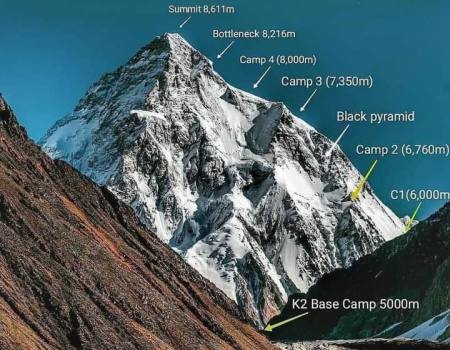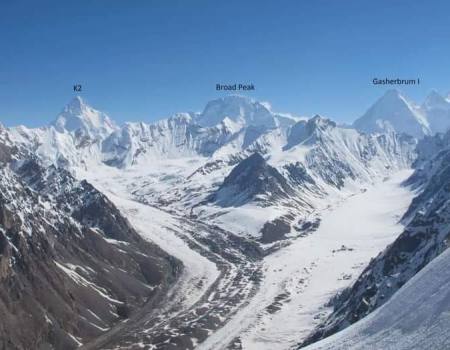Nanga Parbat
Nanga Parbat is also known as (Diamer peak) is located in the Diamer district of Gilgit–Baltistan region, the northern areas of Pakistan, and the western bastion of the Himalaya. Nanga Parbat means “Naked Mountain” in Urdu, Parbat deriving from the Sanskrit word Parvata, meaning “mountain”. The altitude of Nanga Parbat is 8125 m which is the 9th highest mountain in the world and the 2nd highest in Pakistan after K2. Nanga Parbat has a huge vertical relief over local terrain in all directions.
To the south, Nanga Parbat (8126 m) boasts what is often referred to as the highest mountain face in the world: the Rupal Face rises an incredible 4,600 m (15,000 feet) above its base. To the north, the complex, somewhat more gently sloped Rakhiot Flank rises 7,000 m (22,966 feet) from the Indus River valley to the summit in just 27 km, one of the 10 greatest elevation gains in so short a distance on Earth
Nanga Parbat is the second most prominent peak of the Himalayas, after Mount Everest. The key col for Nanga Parbat is Zoji La in Kashmir, which connects it to higher peaks in the remaining Himalaya-Karakoram range. On the Tibetan Plateau, Nanga Parbat is the westernmost peak of the Himalayas whereas Namcha Barwa marks the east end.
Nanga Parbat was one of the deadliest of the eight-thousanders for climbers in the first half of the twentieth century; since that time it has been less so, though still an extremely serious climb. It is also aimmense, dramatic peak that rises far above its surrounding terrain.
The mountain was first climbed by Hermann Buhl on July 3, 1953, via the Upper North ride and Reinhold Messner's first ascent of Rupal face in 1970 via the south East spur, Messner’s solo climb of the Diamer face in 1978. These ascents inspire the climbers to aspire to the Himalayas. Most attempts nowadays are via the Westerly Diamir face which is generally considered to be the easiest and safest with the Kinshofer Route the normal route.
Trip Highlights
Destination: Nanga Parbat (Rupal face)
Group Size: Max. 10 person
Maximum altitude: 8126 m
Grade: Mountaineering Expedition
Season: Spring
Accommodation: Hotel and Camping
Duration: 50 Days
Outline Itinerary
- Day 01:Arrive Islamabad
- Day 02:Briefing at Islamabad
- Day 03:Drive to Chilas(480 km) via Karakoram highway
- Day 04:Drive to Tarashing
- Day 05:Day 05-36 (31 days in Nanga Parbat base camp and total climbing)
- Day 06:Herrligkoffer BC.
- Day 37:Tarishing
- Day 38:Naran
- Day 39:Islamabad
- Day 40:Departure
Detail Itinerary
- Day 1Arrive IslamabadArrive in Islamabad and transfer to the hotel. Welfare meeting in Alpine Club of Pakistan, in the afternoon we enjoy a city tour of Rawalpindi and Islamabad.
- Day 2Briefing at Islamabad
- Day 3Drive to Chilas(480 km) via Karakoram highwayDrive to Chilas via Babusar Pass 4173m. Overnight in tents
Babusar Pass is a high mountain pass at an elevation of 4.173 m (13,691 ft) above the sea level. The pass is the highest point in the Kaghan Valley, Pakistan. The pass connects the Kaghan Valley via the Thak Nala with Chilas on the Karakoram Highway. It’s one of the famous hair pinned roads in the world. - Day 4Drive to TarashingDrive to Astore 112km, 2-3 hrs, here, by Jeeps to Tarashing village, which the last village of Rupal valley and it takes ½ hour
- Day 5Day 05-36 (31 days in Nanga Parbat base camp and total climbing)
- Day 6Herrligkoffer BC.From Tarashing (2911m), climb the Tarashing glacier’s lateral moraine, near the village’s north edge, and cross the glacier on a trail. Continue up the gentle valley through Rupal village. Rising gradually through Rupal lush fields, the trail follows the valley’s north side to Herrligkoffer base camp (3550m)
- Day 37TarishingTrek back to Tarishing, overnight at hotel.
- Day 38NaranDrive back to Chilas, after lunch continue drive to Naran via Babusar Pass 4173m.
- Day 39IslamabadBack to Islamabad 6-7hrs. Overnight at hotel
- Day 40Departure Transfer to Islamabad airport for international flight.
What's Includes:
- Applicable only for Expedition thru Southern Route
- Porters/Yaks to carry equipment and food all the way to BC & back.
- Full board accommodation en-route to/from Base camp.
- One head Climbing guide/Sardar.
- Cook & kitchen boys at BC.
- Experienced & skillful High Altitude Climbing Sherpa (One Sherpa for two Client)
- POISK Oxygen (08 bottles per client & 06 per Sherpa).
- Mask & regulator mask set (must be returned after the Expedition).
- Highly preferable meals at BC with complete hot drink & normal beverages.
- Exported High altitude food for higher camps (ready to eat food).
- Best quality Tents at BC single or twin sharing as per the client desire.
- All necessary kitchen equipment.
- Best quality Dining tent with enough no of table & chairs, plus inside the tent, we
- will set Gas Heaters to make the Dinning hall enough warm.
- Complete carpeting inside the dining tent.
- Comfortable & portable wooden toilet at the base camp.
- A nice portable wooden shower room with hot water at the base camp.
- High-quality high altitude tents for above BC use.
- Necessary climbing hardware gears with fixed ropes.
- Enough EPI (high altitude) gases with burners for higher camps use.
- Oxygen with the regulator set for medical purpose.
- Radio walkie-talkie set to each client with base station & permits cost.
- Satellite phone for an emergency purpose ($ 4 chargeable for a personal call).
- Generator/solar panel with accessories for recharging & power supply purpose.
- Gammon bag for medical purpose.
- Insurance of all local team members.
- All airport/hotel transfers.
- Celebration meal & pre-briefing.
- Expedition blessing Puja arrangement
- Last but most important COMPLETE SETUP INTERM/MIDDLE CAMP with Sleeping bags,
- sleeping mattress, food & drinking stuff & cooking crew.
- Service of Local Climbing Sherpas
- Permit fees including Liaison Officer
- Return airfare services
- Expedition cargo charge
- Fully catered trek to Base Camp and back
- Full supported acclimatization
- Base Camp food
What's Excludes:
- Personal insurance (Suggested to have evacuation policy as well)
- Pakistan visa
- Personal climbing gears.
- Personal nature’s expenses.
- Cost of emergency evacuation
Trip Note
Nanga Parbat Expedition (Rupal face) is technically challenging expedition. The well being of our groups are of paramount importance to us. All of our trips are led by qualified professional Expedition guides and Sherpas who are well trained by our Government. Our job is to ensure your comfort and safety as we take you where you want to go because your holiday is ours. In this regards, we work honestly and effectively to provide you the Himalayan experience that suits your interest. We encourage you to question us freely and contribute in the planning stages of your adventure in the climbing period.
Quick Inquiry
Trip Facts
- Transportation:6
- Meals:Breakfast + Lunch + Dinner
- Accommodation:Lodge + Camping
- Altitude:8126 m


